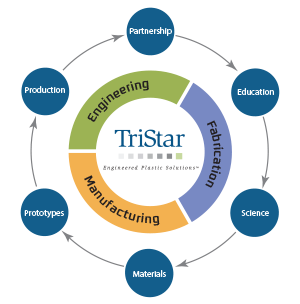
The aerospace industry just turned 120! We launched our guide to performance polymers in the aerospace industry to celebrate.
In this blog, we provide a high-level overview of the aerospace industry today, including its key market segments, top companies, and recent performance.
Aerospace Industry Market Structure and Sub Segments
The aerospace industry is a core pillar of US manufacturing, employing over 500,000 people (about 4% of the total US manufacturing workforce). In the United States, the aerospace industry remains a star performer in terms of international trade. According to the International Trade Administration, the U.S. aerospace sector produces the second-highest level of exports among all manufacturing industries, and the highest overall trade balance. This “predominant position has remained unchanged for decades, with aerospace exports having grown at an average rate of 5.31 percent over the last 10 years and the aerospace trade balance increasing at an average rate of 4.64 percent since 2010.“
Aircraft manufacturing has long been highly concentrated, with a large portion of the market for large commercial passenger aircraft historically dominated by just two companies, Boeing and Airbus. In turn, Embraer (Brazil) and Bombardier (Canada) have long held a dominant position in the market for regional aircraft. However, these manufacturers are served by a vast network of OEMs who engineer the incredible array of subsystems needed to help aircraft perform their missions safely and reliably.
The broader aerospace sector may be divided into sub-industries as follows:
- Commercial Airlines, including large global commercial aircraft manufacturers like Boeing and Airbus, and the many OEMs who support them.
- General Aviation manufacturers and OEMs such as Beechcraft, Cessna, and Piper, who supply the fixed- and roto-wing aircraft used in recreation, utility application, emergency services, and business transportation.
- Airport Infrastructure, capturing the vast array of ground logistics and infrastructure required to keep fleets of aircraft safely in the air.
- Unmanned Aerial Systems (UAS) manufacturers, which comprise a rapidly growing marketing segment providing everything from advanced military drones to small photography and recreational units.
- Military Aircraft, the largest single segment of the US aerospace industry.
- Rockets and Space. While traditionally dominated by defense contractors, the market segment has recently seen increasing market share won by private contractors such as SpaceX, Boeing, and Virgin Galactic.
Aerospace Industry Financial Performance
After relatively stable growth for many decades, the aerospace industry confronted a massive slowdown in the wake of the COVID pandemic and the ensuing supply chain difficulties. However, the industry has been able to rebound successfully; a recent report from PwC notes that:
- “By the end of 2023, aviation should return to pre-pandemic levels and resume a growth trajectory nearly double that of GDP.”
- Orders for major commercial aircraft makers like Boeing and Airbus have rebounded as the companies seek to address a backlog of orders, but production still remains far below pre-pandemic peaks. The “industry backlog of $720 billion and nearly 12,000 units is more than seven years’ worth of production at record production levels.”
- New markets continue to emerge, offering further avenues for aerospace industry growth. commercial UAV adoption, for example, “has progressed rapidly in agriculture applications such as crop monitoring, assessment of soil dryness, precision spraying and livestock monitoring.” New solutions such as heavy-lifting drones could dramatically expand the market for UAVs moving forward.
- Space represents a lucrative future market that is forecast to triple over the next decade to $1.4 trillion, largely driven by demand for satellite internet deployments. Private space missions have grown like never before, and PwC notes that “given the scope of NASA’s current plans — ten crewed missions to the Moon, a permanent Moon space base and ultimately a crewed mission to Mars — the American space sector is likely to see many more such public-private collaborations in coming years.”
What are the largest firms in the aerospace industry?
Based on FlightGlobal data from 2021, Lockheed Martin was the largest aerospace company in the world by revenue, followed by Raytheon Technologies, Boeing, Airbus, and Northrop Grumman. Due to the slow-down in civilian aviation in the wake of COVID, this year’s list marks the first time in many years that the top manufacturer spots have been taken over by suppliers with a greater focus on defense solutions (Lockheed/Raytheon) compared to civilian applications (Boeing/Airbus, the long-term top two by revenue).
Learn More About Aerospace Industry Trends and Materials
While the aerospace industry is over a century old, it remains defined by continuous innovation. In this blog post, we take a look at the most important trends shaping the future of aerospace, including decarbonization, the growth of private space companies, and new possibilities for 3D-printed components.
If you are interested in a deeper dive into dive into the biggest challenges for aerospace industry components (and how TriStar’s high-performance polymers can help solve them) please see our guide here, based on knowledge gleaned from successful engagements with a variety of aerospace industry clients.








